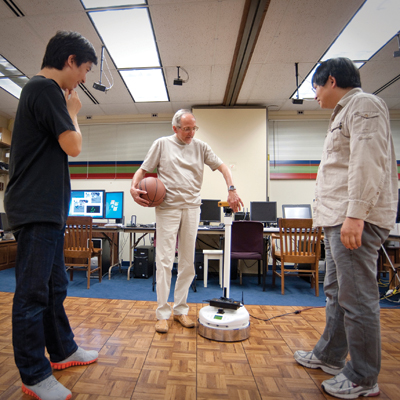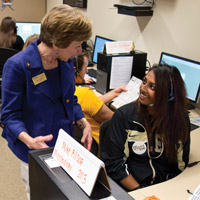At the Speed of Technology
Cutting-Edge Collaborations Help HHS Researchers Bring Innovative Products to the Marketplace
Making Machines See Like Us

Eye, Robot: Zygmunt Pizlo (center), professor of psychological sciences, is working with graduate students to build a robot that can see in 3-D. (Photo provided by the Purdue Research Foundation)
Though he prefers reading science, history and philosophy to science fiction, Zygmunt Pizlo's work could be the subject of an Issac Asimov novel. An electrical engineer turned cognitive psychologist, Pizlo, professor of psychological sciences, has spent 30 years working in the field of visual perception. In short, he's trying to instill human-like vision in robots.
The challenge in developing this artificial intelligence is getting the robots to see the world in 3-D instead of 2-D. "We want to have a robot that can see and interact with us. It's critical then that the principles underlying a robot's vision are identical to the principles of human vision, so we can understand each other," Pizlo says. "If the robot is using laser sensors and we are using eyes, then we are seeing different things."
Pizlo's research group had a breakthrough in 2006 when it found ways to transition from 2-D to 3-D. These days, Čapek, a robot named for the Czech science fiction writer of the early 20th century, "watches" Pizlo's students as they move across a parquet dance floor. Čapek is attempting to conceptualize their actions as they move around desks and chairs.
The patented technology could find its next breakthrough when Čapek is programmed with all knowledge of the physical world that humans have at birth. This will enable him to "see" like humans. "The key element in solving the puzzle of enabling 3-D vision for robots is to realize that our visual system uses a priori knowledge about the physical world," Pizlo says. "The physical world is not completely random. Most natural objects are symmetrical, all objects have volume, gravity is always present and ground surfaces are approximately horizontal. There is enough a priori knowledge hardwired in the human visual system that we automatically see our natural environment in 3-D and we see it veridically, that is, the way it is out there."
The possibilities could be endless should Pizlo's team come up with an algorithm that leads to this robotic "insight." Current applications in manufacturing, space research and agriculture could lead to more interaction with humans. Robots could walk dogs, play cards with the elderly and help the visually impaired, Pizlo says. The smart robots at a manufacturing plant can be made even smarter, and others could be used in high-risk repairs in places like a nuclear power plant.
The National Science Foundation, U.S. Department of Defense, Air Force Office of Scientific Research and the U.S. Department of Energy — all supporters of Pizlo's research — eagerly await his next breakthrough.











